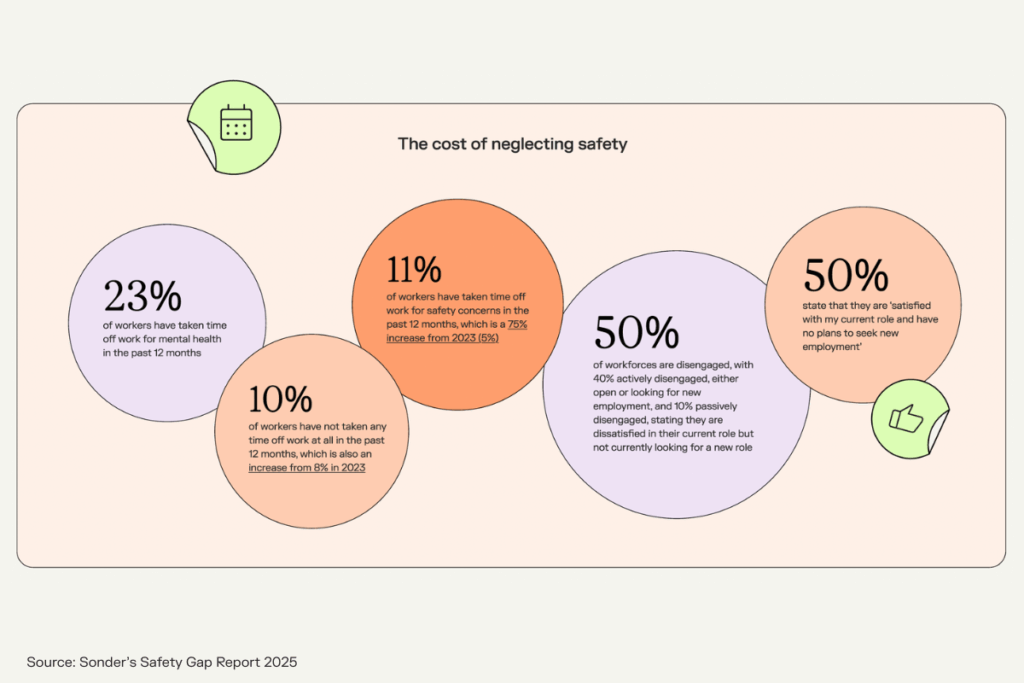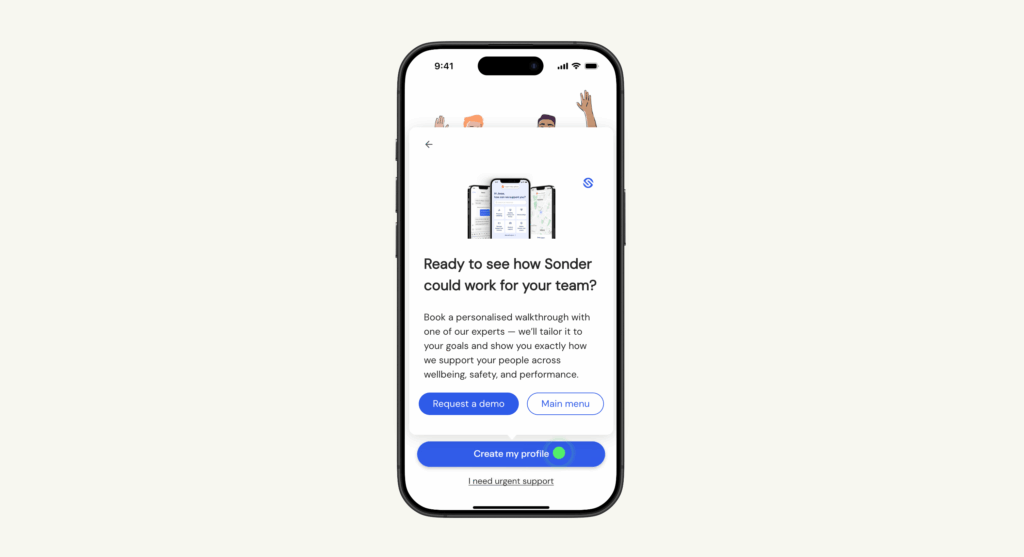As a leader, you want your workplace to feel safe, supportive, and respectful. But even in the strongest teams, challenges can emerge. Maybe you’ve noticed rising tension between colleagues or overheard a careless remark. Perhaps someone seems less ‘themselves’ these days or you’ve heard someone crying in the bathroom. These moments might seem small, or isolated at first, but over time they can point to something more serious: harmful behaviour.
While occasional conflicts are a normal part of working life, harmful behaviour is different. It creates environments where employees feel unsafe, disrespected, or unwelcome. Safe Work Australia recognises harmful behaviour as a psychosocial hazard, which means organisations have a legal duty to prevent and manage it.
The impact also goes beyond compliance. Psychological injury claims now make up 12% of all workers’ compensation claims, but account for 38% of costs. The average claim has nearly doubled in five years, and the hidden costs — absenteeism, turnover, and lost productivity — hit businesses even harder.
We know these challenges can feel overwhelming, particularly when you’re balancing performance, culture, and compliance. That’s why understanding harmful behaviour and how to respond is essential when it comes to building a safe, engaged, and high-performing workplace.
In this article, we’ll explore how to recognise harmful behaviour, manage the risks, and embed prevention strategies that support both your people and your business.
This is part of a series on understanding psychosocial hazards. Other features in the series include:
- Understanding the risk and impact of poor role clarity
- Understanding the risk and impact of imbalanced job demands
Disclaimer: The information contained in this article and on this website is general information only and does not constitute legal advice. Although all efforts have been made to ensure the accuracy and currency of the information presented, Sonder takes no responsibility for any errors or omissions presented. Please contact a legal representative for individual advice.
What is harmful behaviour and why does it matter?
Harmful behaviour isn’t just an awkward interaction or a missed “good morning.” It’s behaviour that creates real risks to wellbeing and culture — and it can creep into any workplace, no matter how committed you are to looking after your people.
According to Safe Work Australia, harmful behaviours are both a psychosocial and physical hazard. Exposure to such behaviour can cause psychological and physical harm to a person or anyone who witnesses the behaviour.
In more tangible terms, harmful behaviour can look like:
- Violence and aggression from the workplace or public — threats, assault, and abuse
- Bullying and harassment — sexual and gender based, racism, ableism, ageism
- Conflict or poor workplace relationships and interactions
Harmful behaviours can move into hazardous territory when they are:
- Severe in nature
- Prolonged over time
- Happening frequently
Extreme examples, such as physical assault, are usually obvious and often swiftly dealt with. The greater challenge lies in recognising and addressing the more subtle behaviours — like sexist remarks, exclusion from meetings, or a culture where aggressive banter is normalised. These can chip away at employee wellbeing over time, often without being formally reported until the damage is done.
When can harmful behaviour happen, and what are the risks?
Harmful behaviour doesn’t occur in a vacuum — it can arise in different contexts, from day-to-day interactions to systemic workplace practices.
Some workers are also more vulnerable due to factors such as sex, gender, sexuality, age, migration status, disability, or literacy levels. These same characteristics can also make people less likely to raise concerns, leaving issues unaddressed.
Workplace conditions themselves can fuel harmful behaviour too. Let’s take a look at some examples:
- High-pressure periods: deadlines, peak seasons, or staffing shortages can heighten stress and trigger aggressive or dismissive behaviour.
- Power-imbalanced relationships: between managers and staff, or senior and junior employees, where authority may be misused.
- Team dynamics: cliques might form, colleagues exclude others, or gossip becomes part of workplace culture, creating toxic dynamics.
- Customer or client interactions: workers may face aggression, harassment, or discriminatory behaviour from the public.
- Within organisational systems: policies or practices that unintentionally disadvantage certain groups, e.g. inflexible rostering that discriminates against carers, or recruitment processes biased against migrants.
- In digital spaces: email, chat platforms, or video calls, where tone can be misinterpreted or used to harass, exclude, or intimidate others.
- Remote or hybrid work settings: a lack of visibility may make behaviours like exclusion from meetings or withholding information harder to spot.
How to identify the signs of harmful behaviour
The first step in addressing harmful behaviour is knowing where it exists in your workplace.
And be mindful — don’t assume your workplace is free from harmful behaviours simply because no one has raised a concern. If you’ve never experienced racism yourself, for example, it can be easy to overlook subtle microaggressions or other insidious behaviours that cause real harm.
Because many forms of harmful behaviour can easily slip under the radar or go unreported, leaders need to be proactive. So where can you start?
There are several ways you can build a picture of what’s happening in your team:
| Action | Assessment |
| Listen to your people | Workers are unlikely to use the term “harmful behaviour,” but they might describe feeling stressed, humiliated, uncomfortable, upset, or afraid. Concerns about workplace culture or relationships can be early warning signs. |
| Use surveys and tools | For larger organisations, the People at Work psychosocial risk assessment tool can help uncover issues that may not be raised directly. |
| Observe behaviours and interactions | Some harmful behaviours, like physical violence, are obvious and rarely tolerated. Others are more subtle, such as crude language, exclusion, or a culture of sexist jokes, and can be harder to identify — apply deliberate attention. |
| Review existing data | Patterns of overtime, absenteeism, injuries, incident reports, or workers’ compensation claims can highlight risks that might otherwise be missed. |
| Encourage reporting | Workers are far more likely to raise concerns if they believe they’ll be taken seriously and treated respectfully. Make it easy and safe for them to speak up and ensure your managers are trained to lead with empathy. |
| Look at all the risks present | Hazards often interact. For example, employees under high job demands may be more likely to behave harmfully towards others, or those who are isolated may be experiencing unreported aggression. These risks can compound and escalate quickly. |
| Consider exposure and vulnerability | The longer, more frequent, or more severe the behaviours, the greater the risk of harm. The risks also rise further when someone faces multiple forms of discrimination. Some workers — based on factors such as sex, gender, sexuality, age, migration status, disability, or literacy — may be more vulnerable and less likely to report what they’re experiencing. |
Alongside genuine care for your people, it’s important to remember that harmful behaviours are classified as a psychosocial hazard. This means organisations have a legal duty to identify, assess, and manage them — just as they would with physical risks.
What are some strategies to mitigate or resolve harmful behaviour?
Managing harmful behaviour requires both a proactive and a reactive approach. Proactively, leaders can build a culture that prevents harm and strengthens workplace relationships. Reactively, they need clear, fair systems to address issues when they do occur.
The most effective strategies bring these together to create a safe, respectful, and accountable workplace.
Try these practical strategies:
1. Prevention and culture building
- Set clear behavioural standards: Develop and actively promote clear behavioural standards with specific examples of acceptable and unacceptable conduct.
- Strengthen team connections: Use regular team-building activities to build trust, communication skills, and conflict resolution capacity.
- Break down silos: Encourage cross-functional projects that support employees in building relationships outside of their immediate department or teams.
- Set team protocols: Provide guidelines for respectful communication, especially during high-pressure situations.
2. Organisational support system
- Train managers: Provide training in psychological first aid and early intervention techniques for mental health concerns, so managers are equipped to respond.
- Establish peer mentoring programs: Introduce this method so experienced employees can support newer team members.
- Check in regularly: Implement “check-in” protocols during high-stress periods such as busy seasons, organisational changes, and personal crises.
- Plan for returns: Develop return-to-work programmes that provide graduated support for employees recovering from psychological injuries or returning from extended periods of leave.
3. Formal response systems
- Diversify reporting channels: Offer multiple support channels, including Employee Assistance Programmes, anonymous reporting, and external mental health services.
- Investigate promptly and fairly: Respond to all reports with clear timelines and transparent communication.
- Use restorative justice approaches: Where appropriate, focus on repairing relationships and preventing recurrence, not just punishment.
- Ensure accountability: Communicate clear consequences for inappropriate behaviour to reinforce standards.
How do you embed these into your organisational structure?
Lasting change comes when strategies are woven into the fabric of your organisation. Embedding them into culture means moving beyond one-off initiatives and making respect, safety, and accountability part of everyday working life.
Leaders can embed them by:
- Modelling respectful behaviour
- Reinforcing expectations in communication and processes
- Recognising and rewarding positive behaviour
- Providing ongoing learning for respectful and empathetic behaviour
- Monitoring progress over time and adapting proactively
Done consistently, these actions shift culture from reactive to preventative, protecting both people and performance.
Step up your workplace wellbeing with Sonder

Stepping up to harmful behaviour isn’t something leaders have to do alone. Sonder provides on-demand support that complements your workplace culture and helps protect both people and performance by offering:
- 24/7 access to personalised care — from mental health support to safety and medical guidance, so employees never feel alone when issues arise.
- Relief for leaders and managers — easing the pressure of being the sole point of contact when harmful behaviour or conflict surfaces.
- A consistent safety net — giving employees confidential, professional support that not only helps them navigate incidents but also strengthens overall workplace wellbeing.
Ready to see Sonder’s features in action? Request a demo to try it now and see for yourself.






